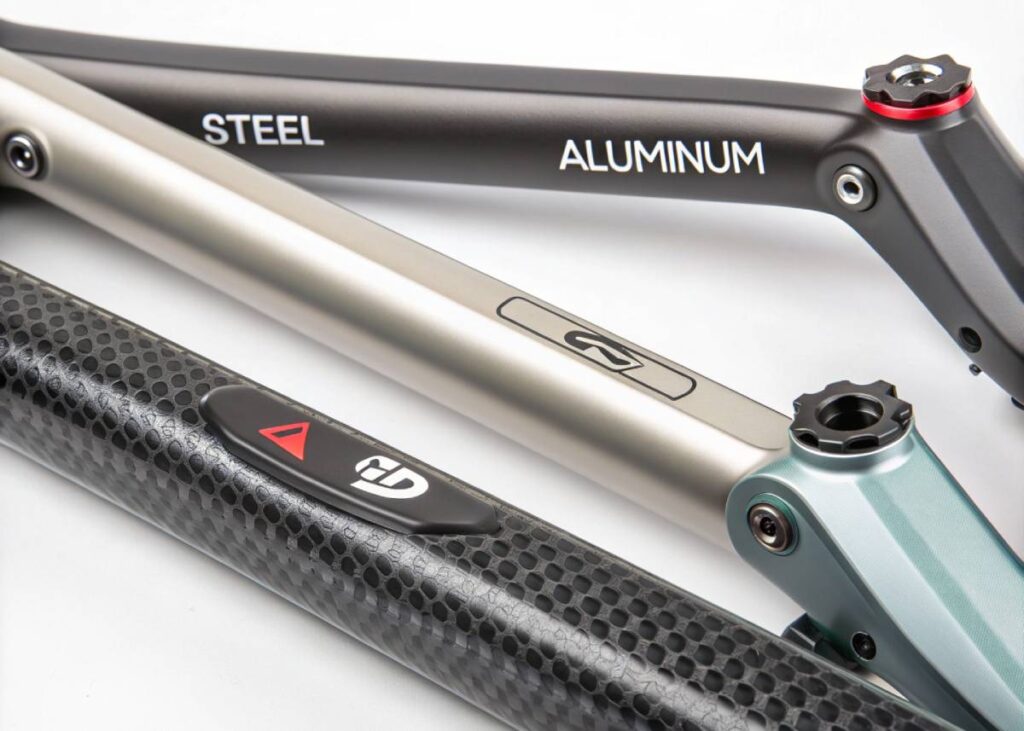Ready to take your cycling experience to the next level? Whether you’re a seasoned rider or just starting out, understanding the weight limits of electric bikes is crucial for a safe and smooth ride.
Dive into our comprehensive guide where we unveil everything you need to know about e-bike weight capacities, ensuring your ride remains powerful, reliable, and tailored to your needs.
Let’s empower your journey with the knowledge that keeps you rolling confidently!
Electric Bike Weight Limits
When diving into the world of electric bikes, it really helps to know about weight limits. This little tidbit keeps you safe and keeps your ride from going all wonky on you.

Understanding Weight Limits
Electric bikes, or ebikes for the cool kids, usually handle around 300 to 350 pounds. They’re built tough, plus they have some motor muscles to boot. This means they fit a whole bunch of folks, even if someone might need a bit of extra support weight-wise. That’s good news for anyone on a roll.
| Bike Type | Weight Limit (lbs) |
|---|---|
| Standard Road Bike | 220 – 250 |
| Heavy-duty/Specialty Bike | 300 – 350 |
| Electric Bike | 300 – 350 |
These weight limits aren’t picked out of thin air. They come from the bike’s design and what it’s made of. Push a bike past its limit, and things can get dicey—it changes how it rides, how fast it goes, and how you steer. And nobody wants surprises when they’re cruising.
Types of electric bikes and their specific uses really matter here. So think about:
- Urban commuters might lean towards lighter rides with more chill weight limits.
- Delivery folks might need those beefier bikes that can carry more heft.
If you’re checking out various bike styles, peep our electric bike classifications guide to find your match. Always take a gander at what the manufacturer says—those specs are golden for safe riding and keeping your bike in tip-top shape. And, for tips on keeping your e-bike running smooth, take a look at our guide on electric bike maintenance.
Factors Influencing Weight Capacities
When you’re sizing up electric bikes, it’s important to peek at what factors crank up their weight limits without losing your head. These bits and pieces decide just how much weight a bike can safely lug around town.
Component Weight Contribution
The guts of an electric bike play a big part in how much weight it can haul. So, let’s chat about the hunks and chunks that pack on the pounds.
1. Frame Material
Think of the frame as the skeleton—it holds everything together and has a huge say in how much a bike can carry. Heavy-duty e-bikes often have rock frames made from things like steel or top-shelf aluminum. Steel’s the tough guy but a bit bulky, while aluminum strikes a decent deal between muscle and mass.
| Frame Material | Traits | Weight Impact |
|---|---|---|
| Steel | Tough as nails, hefty | High |
| High-grade Aluminum | Strong and nimble | Moderate |
| Carbon Fiber | Light and pricey | Low |
2. Wheels and Tires
The wheels are doing the heavy lifting, literally. Bikes for bigger folks usually come with wheels that could survive a stampede—double-walled rims and tires wide enough for a comfy ride are the secret sauce here.
| Wheel Part | Traits |
|---|---|
| Double-walled Rims | Double the strength, better weight handling |
| Wider Tires | More balance, smoother cruise |
3. Motor and Battery
Here’s where the electric part struts its stuff. Motors add some heft but dish out the power you need to keep rolling no matter the weight. Batteries come in all shapes and sizes but the bigger watt-hours they pack, the heavier they get.
| Gadget | Traits | Weight Impact |
|---|---|---|
| Motor (Hub or Mid-Drive) | Heavy, but gives pep | Moderate to High |
| Battery | More juice adds on pounds | Moderate to High |
4. Saddle and Seat Post
A comfy tush makes for happy rides, especially if you’re a heavy rider. So, saddles go wide, and seat posts get beefed up. Sure, they add some weight, but they make each ride feel a lot more cozy.
| Part | Traits | Weight Impact |
|---|---|---|
| Wide, Padded Saddle | Comfy for bigger bodies | Moderate |
| Reinforced Seat Post | Extra support | Low to Moderate |
5. Brakes
Safety first! Good electric bikes sport strong brakes. Disc brakes get the job done, they’re trustworthy but do add a bit more to the scale.
| Brake Type | Traits | Weight Impact |
|---|---|---|
| Disc Brakes | Serious stopping power | Moderate |
Grasping what each component contributes lets city cruisers and fitness fans know what to look for in an ebike that won’t leave you stuck on a hill. Need more nitty-gritty? Check out our helpful guides on ebike frame materials and electric bike power ratings.
Best Electric Bikes for Heavy Riders
Picking the right electric bike for heavier folks is key to making sure the ride is smooth and safe. Let’s have a look at some top e-bikes out there that can handle more weight.
Aventon Aventure.2
The Aventon Aventure.2 is a solid option if you’re looking for an e-bike that supports a lot of weight—up to 400 lbs, in fact. Not only that, but it’s great for riders of various heights, anywhere from just under five feet to those towering over six feet. That means it works for just about anyone, whether you’re a petite rider or a giant among us.
| Feature | Specification |
|---|---|
| Weight Capacity | 400 lbs |
| Height Range | 4’11” – 6’4″ |
Wondering about weight limits on other bikes? Take a peek at our article on electric bike weight limits.
Ride1UP Revv 1 FS
For big riders who also want a zippy ride, the Ride1UP Revv 1 FS is a great choice. Built tough, it can carry up to 400 lbs, and it’s sized for people from 5’2″ to 6’4″. It’s a bike that doesn’t just promise power—it delivers it.
| Feature | Specification |
|---|---|
| Weight Capacity | 400 lbs |
| Height Range | 5’2″ – 6’4″ |
Looking to keep your ride running smoothly? Check out our electric bike maintenance guide.
“E-bikes designed for higher weight capacities offer unmatched reliability and comfort, making them a perfect choice for riders who need that extra support without compromising on performance.” – John Smith, Bicycle Industry Expert
Electric Bike Company Model R
If you’re on the hunt for a beast of a bike, check out the Electric Bike Company Model R. It holds up to 420 lbs—making it one of the strongest e-bikes around. Handy for those ranging from five feet to a tall 6’10”, catering to nearly everyone out there.
| Feature | Specification |
|---|---|
| Weight Capacity | 420 lbs |
| Height Range | 5′ – 6’10” |
Thinking about sprucing up your bike? Check out our diy ebike conversion article.
Velotric Discover 2
The Velotric Discover 2 is a big winner when it comes to carrying capacity. It comfortably handles up to 440 lbs and works for riders from petite to powerfully tall, stretching from just under five feet to a bit over six feet. It’s an all-around champ for those who need flexibility.
| Feature | Specification |
|---|---|
| Weight Capacity | 440 lbs |
| Height Range | 4’11” – 6’4″ |
Want to keep your e-bike juiced up longer? Swing by our electric bike battery care guide.
Each of these e-bikes offers a unique mix of strength and ease of use. For more goss on e-bike types and finding your match, scoot over to our article on ebike classifications.
Importance of Weight Limits
Safety Considerations
Alright, folks, let’s talk about why sticking to weight limits on electric bikes is like keeping your diet promise – crucial for saving you from a world of hurt. Piling on too much weight can turn your trusty ride into a ticking time bomb, possibly snapping the frame or bending the wheels in ways you really don’t want to experience. And don’t even get me started on what happens to the brakes. Our friends at Tesway underline it: too much weight is a big red flag.
When you’re in the market for an electric bike and you’ve got a bit more to carry, here’s what you want to focus on:
- A solid frame, the kind made from steel or premium aluminum
- Wheels that can take a beating—think double-walled rims
- A wide, comfy seat for those looong rides
- Smooth suspension because you deserve it
- Sturdy brakes, preferably disc-style, for sudden stops
Most electric models can usually handle between 300 to 350 pounds, thanks to their bulky build and that powerful little motor. Take Pedego for example; they have a variety that maxes out at 250 pounds on its own, but with a sprinkle of Magnesium Wheels magic, it boosts up to 350 pounds. Their Stretch and Tandem models? We’re talking a hefty 400 pounds.
Keeping your bike within these limits ensures all those safety features keep doing their job well, letting you cruise without any extra stress on you—or your bike.
Performance Impacts
Now here’s the deal: load your bike like it’s a pack mule, and you might ride like one. Exceeding the advised weight messes with how your bike moves and grooves. You might notice:
- It’s harder to steer and turn around
- Speed and acceleration? Slower than watching paint dry
- Your bike’s parts might age faster than a fine cheese
Stick to what the label says about how much weight is too much. That way, you’ve got a ride that’s not just safe but also smooth and cool. Your bike and its wallet-alike parts will last longer, providing efficient, reliable transport whenever you desire. For more on how to keep your commuter companion at peak performance, check out our articles on electric bike performance impacts and ebike range factors.
So, play it smart, stay within the limits, and you’ll enjoy not just the ride, but a longer-lasting bike with fewer hiccups along the way. That’s the way to roll!
Battery Details and Weight
Getting the lowdown on electric bike batteries is key, especially for those with an eagle eye on weight limits and how it all plays out on the road. Let’s chew over two main things: the heft and juice of the battery, plus the different varietals of batteries in the e-bike buffet.
Battery Weight and Capacity
The weight of a bike’s battery can throw the whole balance of the ride like a sumo wrestler on a seesaw. Batteries? They ain’t all created equal—some weigh more than a sack of spuds! Take a 52V 70-cell model; it tips the scales at around 10.6 pounds.
| Battery Spec | Weight (lbs) |
|---|---|
| 52V 70-cell | 10.6 |
Battery capacity—the stuff that gets you from A to B—is measured in watt-hours (Wh). It’s like gas for a car but, you know, sportier and greener. E-bike batteries generally pack enough punch to cover 25 to 70 miles on a single charge, depending on how much oomph you’re using (Juiced Bikes).
| Battery Capacity (Wh) | Range (miles) |
|---|---|
| 998 Wh | 67 (medium speed), 33 (high speed) |
Wanna squeeze more miles outta your battery? Check out our guide on electric bike battery care.
Battery Types for Electric Bikes
The e-bike world isn’t battery-monogamous. Different types strut their stuff, each with its own quirks. The big dogs here are lithium-ion and lead-acid batteries.
- Lithium-Ion Batteries: Quite the rock stars in the e-bike scene. They’re compact, long-lasting, and generally the MVPs in performance, they’re low fuss too. Juiced bikes sing their praises with standardized UL 2271-certified versions for that extra layer of safety.
- Lead-Acid Batteries: Like the grandpas of the battery world. They’re cheaper but come with more bulk and a shorter life span—so they’re mostly taking a rest off the e-bike stage nowadays.
Pickin’ the right battery is like choosing the right sidekick—essential! For more dirt on the different power options, head to our page on ebike battery types.
If you’re one of those who like to poke under the hood or got some particular needs to scratch, swing by our info centers on ebike battery voltage, ebike battery care, and how to charge ebike.
Types of Electric Bikes
Picking the right electric bike sounds tricky, huh? Don’t worry, we’ve got you. E-bikes come in four flavors, each with its own quirks and rules. Let’s unpack what makes each one special.
Class 1 E-Bikes
Class 1 e-bikes are like that friend who needs a nudge to get going. They only help out when you pedal, and they top out at 20 mph. Great for city folks heading to work or folks getting in their cardio fix. It’s where the hustle meets the muscle.
| Feature | Details |
|---|---|
| Pedal Assist | Yes |
| Throttle | Nope |
| Top Speed | 20 mph |
| Typical Uses | Commuting, Fitness |
Class 2 E-Bikes
Class 2 e-bikes are like the multi-tool of bikes—they do it all. They’ve got an assist and a throttle. Keep pedaling if you feel like it or let the bike do the sweaty stuff. They’re all about making life easy, especially if you have physical needs (Aventon Bikes).
| Feature | Details |
|---|---|
| Pedal Assist | Yes |
| Throttle | Yup, sure thing |
| Top Speed | 20 mph |
| Typical Uses | Leisure, Delivery |
Class 3 E-Bikes
Class 3 is the speed demon of the group, hitting a zippy 28 mph. These bikes come with a few strings—think age restrictions and certain no-go zones. Perfect for longer rides when you want to feel the wind in your hair.
| Feature | Details |
|---|---|
| Pedal Assist | Yes |
| Throttle | Yep |
| Top Speed | 28 mph |
| Typical Uses | Long-Distance Commuting |
Class 4 E-Bikes
Class 4 e-bikes pack more punch than grandma’s secret chili. With motors over 750 watts, they go faster than 28 mph. But they’re more like scooters and need licenses and insurance. Trails aren’t their jam, but they’re awesome for special deliveries.
| Feature | Details |
|---|---|
| Pedal Assist | Yes |
| Throttle | You bet |
| Top Speed | >28 mph |
| Typical Uses | Delivery Services |
Figuring out this e-bike puzzle helps you ride the one that feels just right. For more geeky details, jump to our page on ebike classifications and if you’ve got one of these speedsters, our tips on electric bike maintenance will keep you cruising.
Conclusion
In the world of electric biking, knowing your bike’s weight limits isn’t just a technical detail—it’s a cornerstone of safety and performance.
From selecting the right frame material to choosing the best components, every factor plays a pivotal role in ensuring your ride remains smooth and reliable.
Whether you’re a heavy rider or simply seeking a bike that can handle your daily commute with ease, our guide has equipped you with the essential insights and top recommendations.
Stay within the limits, choose wisely, and enjoy a riding experience that’s both empowering and enduring. Here’s to many safe and exhilarating miles ahead!
FAQs
What is the typical weight limit for most electric bikes?
Most electric bikes handle between 300 to 350 pounds, thanks to their robust design and powerful motors.
Can exceeding the weight limit damage my e-bike?
Yes, surpassing the weight limit can compromise the bike’s frame, wheels, brakes, and overall performance, leading to potential safety hazards.
Are there electric bikes designed specifically for heavier riders?
Absolutely. Models like the Aventon Aventure.2 and Velotric Discover 2 are built to support up to 440 pounds, offering enhanced durability and comfort.
How does battery weight affect the overall performance of an e-bike?
A heavier battery can impact the bike’s balance and handling, but higher capacity batteries provide longer ranges, which can be beneficial for heavy riders.
What gear is essential for heavy riders using electric bikes?
Essential gear includes sturdy helmets, high-capacity lights, reinforced saddles, reliable brakes, and robust cargo racks to ensure safety and enhance performance.




